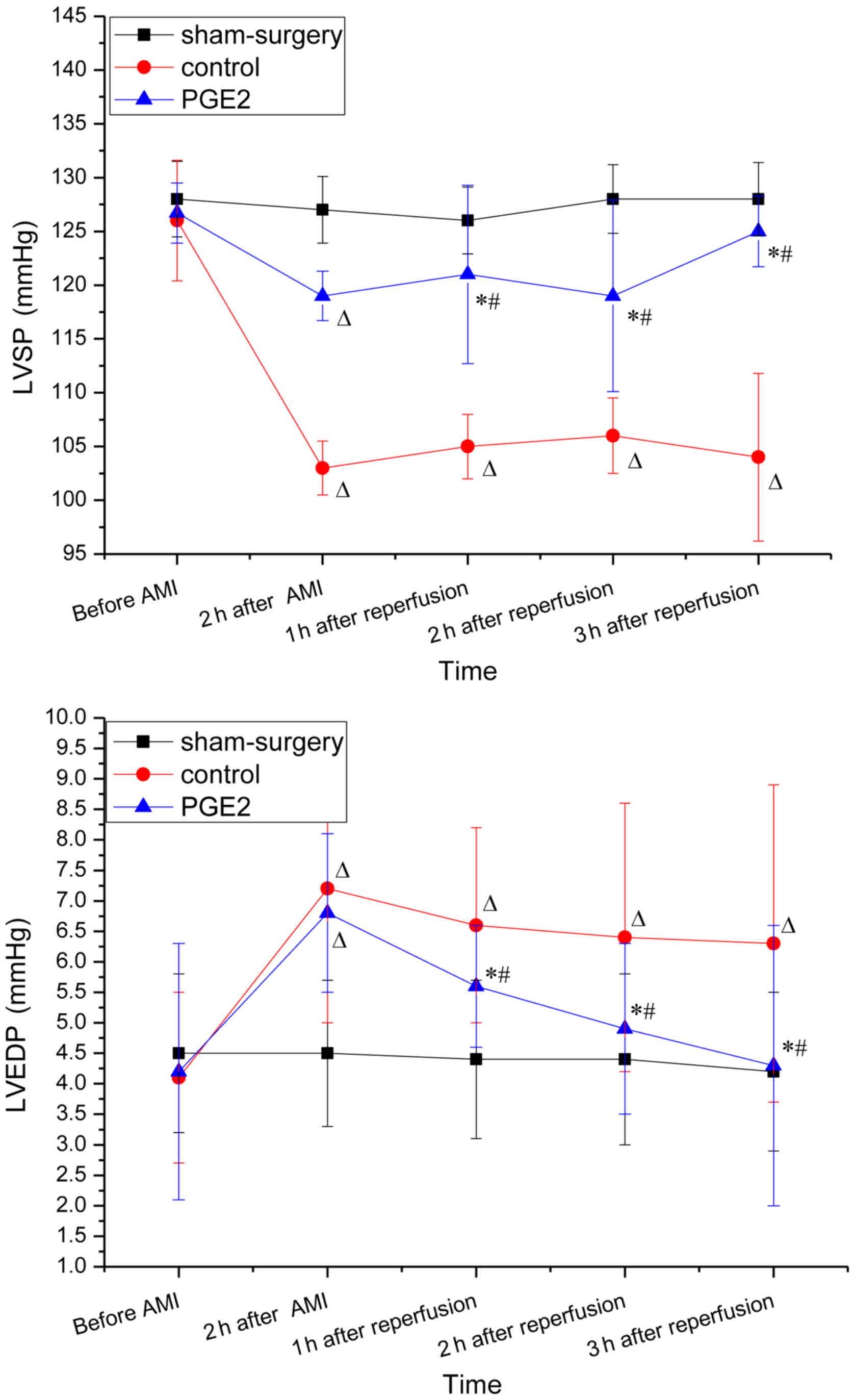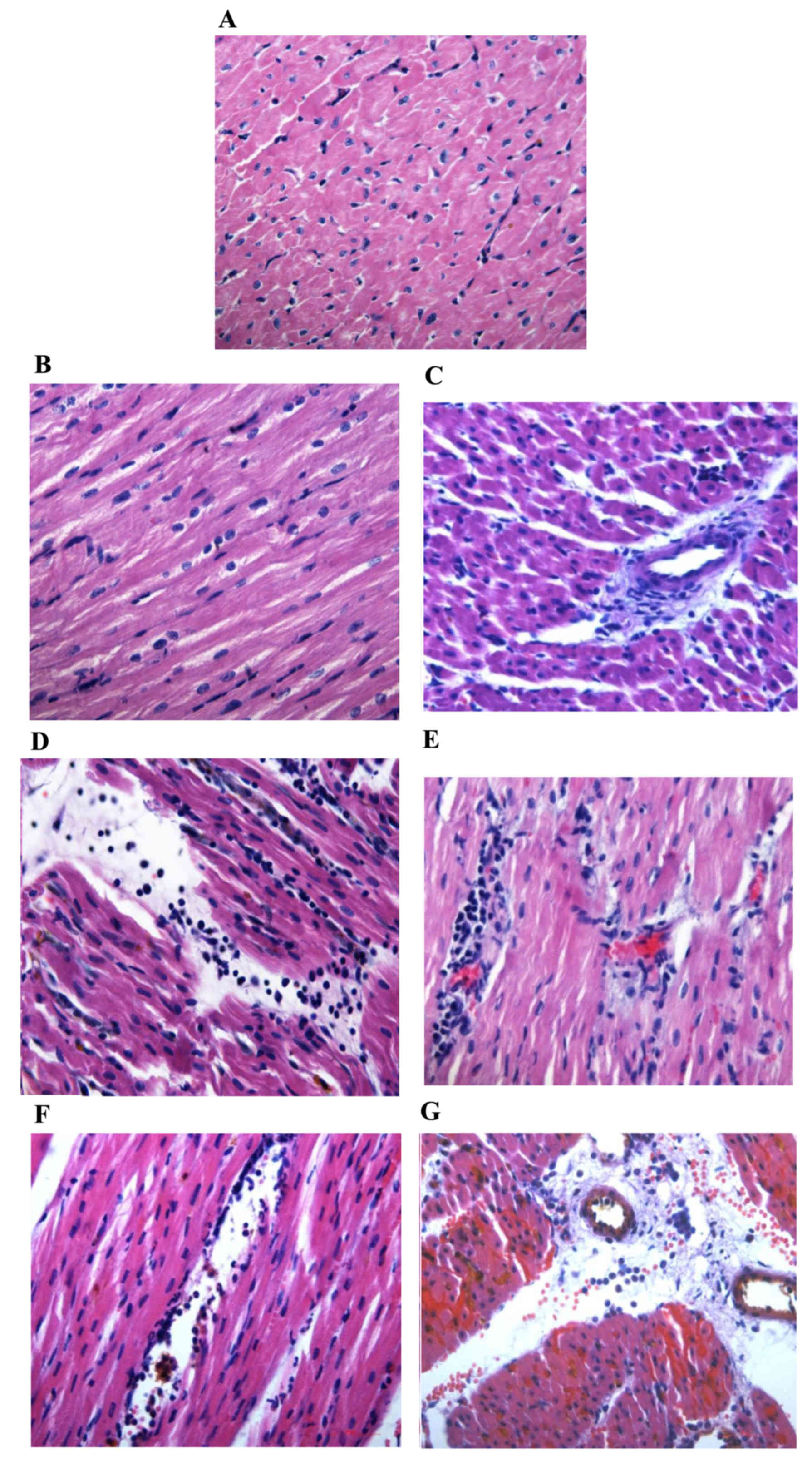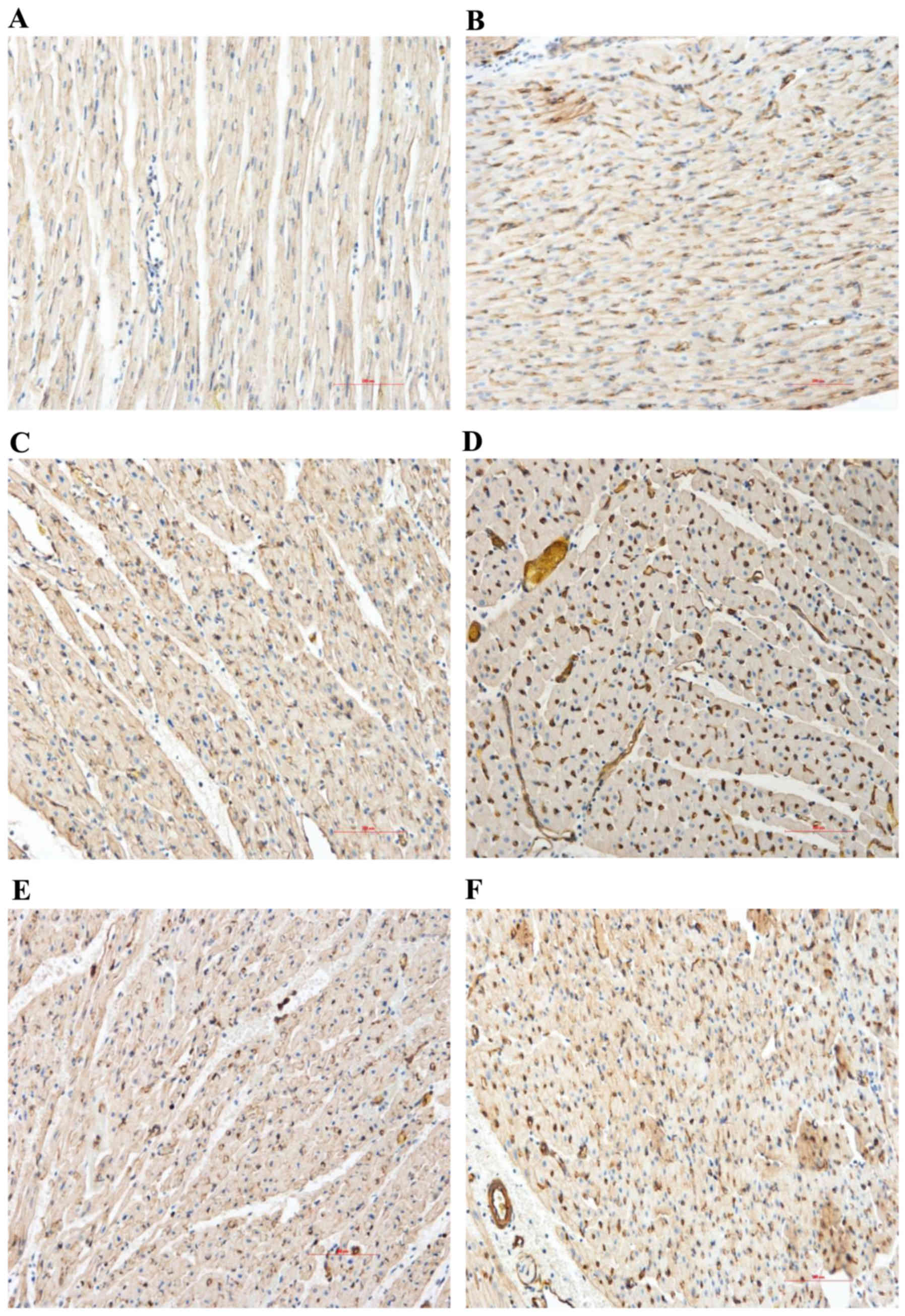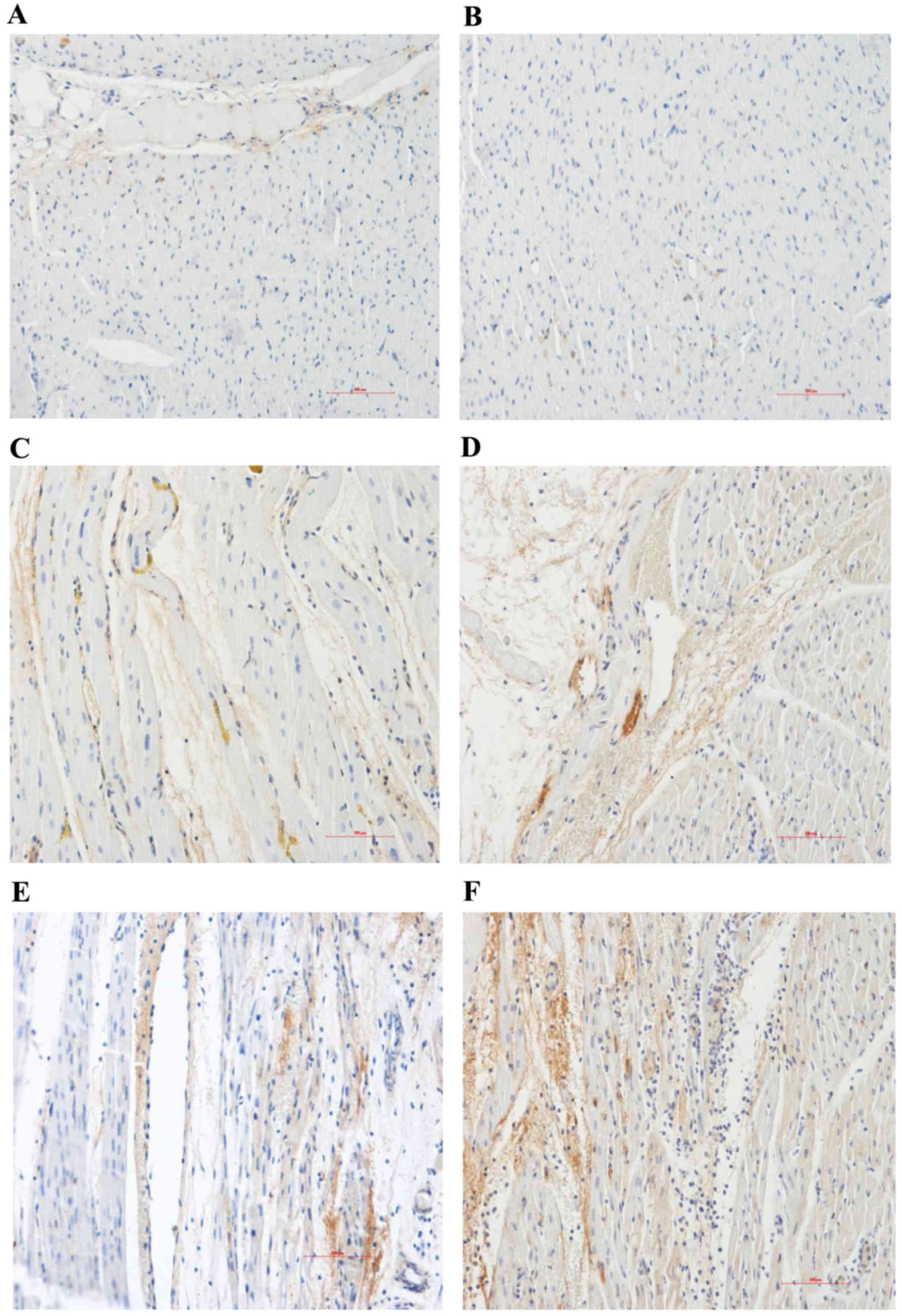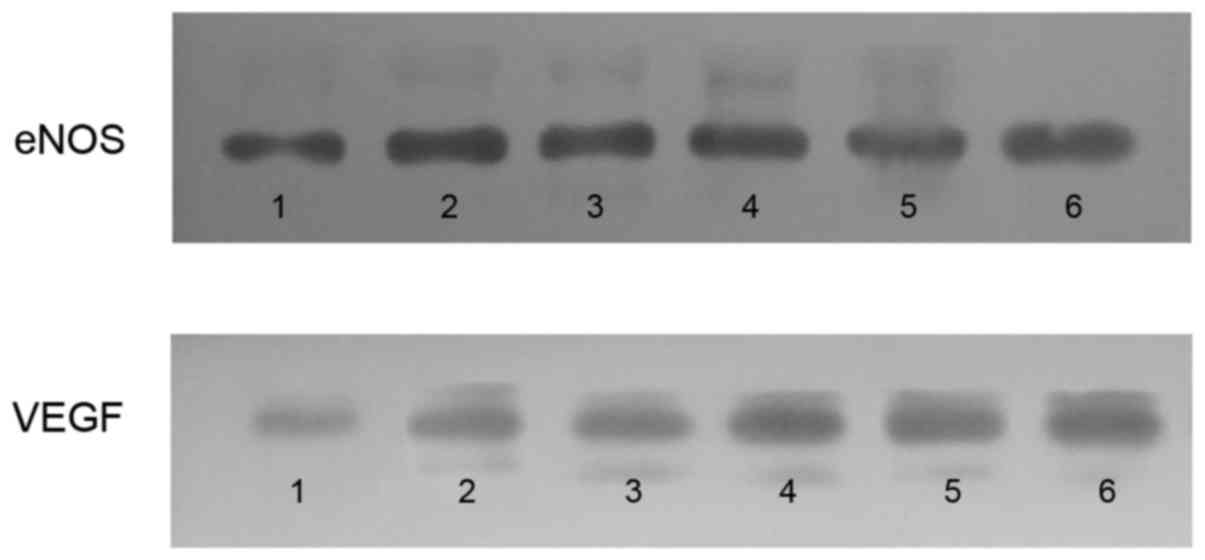Prostaglandin E2 reduces swine myocardial ischemia reperfusion injury via increased endothelial nitric oxide synthase and vascular endothelial growth factor expression levels
- Authors:
- Published online on: December 29, 2016 https://doi.org/10.3892/br.2016.834
- Pages: 188-194
-
Copyright: © Zhou et al. This is an open access article distributed under the terms of Creative Commons Attribution License.
Abstract
Introduction
Acute myocardial infarction (AMI) remains a leading cause of mortality worldwide (1), and reperfusion of the ischemic myocardium is a valuable approach for limiting infarct size (IS). However, reperfusion alone leads to reversible and irreversible injuries in the ischemic myocardium, which is called ischemia-reperfusion (I/R) injury (2,3). Prostaglandin E2 (PGE2) has been demonstrated to be beneficial during cardiac I/R (4,5). Previous studies indicate that endogenous PGE2 protects the heart from I/R injury in vivo and in vitro by promoting collateral vessel growth (4). However, the underlying mechanism of PGE2 in cardiac I/R injury remains unknown.
In AMI, expression levels of vascular endothelial growth factor (VEGF) have been reported to be upregulated, which diminished I/R injury (6). Endothelial nitric oxide synthase (eNOS), a rate-limiting enzyme for the synthesis of prostaglandins (PGs), has been reported to be induced in the heart during I/R (7). This result is consistent with the fact that production of PGE2 in the heart increases significantly during ischemia (8), suggesting that it is significant in cardiac I/R injury. The aim of the present study was to investigate whether PGE2 affected expression levels of VEGF and eNOS in a catheter-based porcine model of AMI.
Materials and methods
Animal experiment protocol
The Animal Research Committee of China-Japan Friendship Hospital (Beijing, China) provided ethical approval for the experiments. The investigations conformed to the Guide for the Care and Use of Laboratory Animals published by the US National Institutes of Health (NIH publication, 8th edition) (9).
Twenty-two male Chinese miniature pigs (weight, 25±3.2 kg; age, 6 months) procured from China Agricultural University (Beijing, China) were selected for the experiment. The pigs were housed separately in the Animal Lab Center of China-Japan Friendship Hospital at a temperature of 20°C and humidity of 50% under a 12-h light/dark cycle. They had free access to food of normal cholesterol content. The porcine model of AMI was created on the basis of a previous study by Suzuki et al (10) with modifications. The distal segment of the left anterior descending (LAD) coronary artery was completely occluded by a dilated balloon (2.0×10 mm) for 2 h. Successful construction of the AMI model was confirmed by findings of coronal artery angiography (CAG) and electrocardiogram (ECG). The LAD coronary artery was then reperfused for 3 h, followed by repeat CAG to ensure the presence of thrombolysis in MI (TIMI) grade 3 blood flow in the LAD coronary artery.
Twenty-two Chinese miniature pigs were randomized into 3 groups as follows: Sham-surgery (n=6), control (n=8) and PGE2 (n=8) groups. The distal segment of the LAD coronary artery of the control and PGE2 groups were occluded by dilated balloon for 2 h followed by a 3-h reperfusion. PGE2 (1 µg/kg; Beijing Tide Pharmaceutical Co., Ltd., Beijing, China) was injected from 10 min before LAD occlusion to 1 h after reperfusion in the PGE2 group. Saline was used instead of PGE2 in the control group. In the sham-surgery group animals, a balloon was placed in the LAD coronary artery, but was not dilated. There was no AMI reperfusion and no-reflow in the sham-surgery group.
Hemodynamic assessment
Left ventricular systolic pressure (LVSP), LV end-diastolic pressure (LVEDP) and heart rate (HR) were obtained via a 6F pigtail catheter method prior to AMI, 2 h after occlusion, and 1, 2 and 3 h after reperfusion for serial monitoring of cardiac function. The baseline hemodynamic parameters were measured prior to AMI.
Measurement of necrosis and no-reflow area (NRA)
Double-staining with 0.01 g/ml Evans blue dye and 0.04 g/ml Thioflavin-S was performed to delineate the reperfusion area (RA) and no-reflow area (NRA). Three hours after reperfusion, 1 ml/kg of 4% Thioflavin-S in saline was injected as a bolus. The reperfused area was stained, but the NRA was not stained. After another complete occlusion of the LAD coronary artery, 0.01 g/ml Evans Blue dye was infused into the left ventricle and the normal myocardium was stained to negatively mark the territory of the occluded artery (i.e., the risk area).
The deeply anesthetized swine were sacrificed by injection of 15% KCl (1 ml/kg). Then the heart was excised and rinsed in ice-cold saline solution to remove the blood and excess dye. The atria and right ventricular free wall were removed, and the remaining LV tissue was sectioned perpendicular to its long axis into six to seven sections and photographed. The risk area (the area unstained by Evans Blue) was traced and visualized under natural light. The NRA (the area not perfused by Thioflavin-S) was photographed using ultraviolet light (wavelength, 365 nm) and a yellow filter. The area between the risk area and NRA was the area of reflow. The normal area was defined as the area not including the RA, NRA and risk area. The RA, NRA and LV wall area (LVWA) were measured using image processing software IPP 6.0. Outcomes were calculated as follows: RA (%) = (RA/area of left ventricle) × 100; NRA (%) = (NRA/risk area) × 100%. In addition, RA/LVWA and NRA/LVWA were calculated.
The normal area, RA and NRA were then fixed using 10% formalin and embedded in paraffin for histopathological examination by hematoxylin and eosin (H&E) staining. Neutrophil infiltration in the area of reflow was semi-quantified by light microscopy (Nikon Eclipse E400; Nikon Corporation, Tokyo, Japan) at a magnification of ×400, in a blinded manner by a cardiac pathologist.
Immunohistochemical staining for VEGF and eNOS
In immunohistochemical analysis, cross-sectional myocardial slices at the level of LV papillary muscles were selected. Normal area, RA and NRA were fixed by 10% formalin and embedded in paraffin. Tissue sections (5 µm) were deparaffinized and re-hydrated. Samples were then subjected to 0.1% Triton X-100 for permeability. The endogenous peroxidase activity was subdued by treating with 3% hydrogen peroxide for 10 min. The paraffin-embedded sections were incubated with anti-VEGF antibody (Abcam, Cambridge, USA; cat. no. ab69479) and anti-eNOS antibody (Abcam; cat. no. ab66127) at a dilution of 1:200, or with negative control (normal serum) at 4°C overnight. The sections were stained with horseradish peroxidase conjugated secondary antibody (Histofine Simple Stain Mouse MAX PO (R), Nichirei Biosciences Inc. Tokyo, Japan; cat. no. 414341F) and 3,3′-diaminobenzidine tetrahydrochloride and counterstained with hematoxylin. The percentage of positive staining for VEGF and eNOS were calculated and six fields selected in a clockwise direction were observed at a magnification of ×200 under a stereo microscope. The expression levels of VEGF and eNOS were observed as brown particles in the myocardial and perivascular tissue samples, and the sum of integrated optical density (IOD) and total positive areas of each group were measured using an image processing software IPP 6.0. IOD to area ratios were calculated as the sum of IOD divided by the total positive area. These measurements were performed three times and were analyzed by two independent observers who were blinded to the treatment allocation.
Western blot analysis for protein expression of VEGF and eNOS
Total protein was extracted from the left ventricle using cell lysis buffer (Cell Signaling Technology, Inc., Danvers, MA, USA) with protease inhibitor cocktail (BD Biosciences, San Jose, CA, USA). Protein samples (20 g) were denatured in SDS sample buffer [125 mmol/l Tris-HCl (pH 6.8), 50% glycerol, 2% SDS, 5% mercaptoethanol and 0.01% bromophenol blue] were subjected to SDS-PAGE and blotted onto Immobilon-FL transfer membranes (EMD Millipore, Billerica, MA, USA). The blotted membranes were blocked with 5% skimmed milk in Tris-buffered saline containing 0.1% Tween-20 for 2 h and subsequently incubated with the primary antibodies against VEGF, eNOS and glyceraldehyde-3-phosphate dehydrogenase (GAPDH; Quanshijin Biotechnology Inc., Beijing, China; cat. no. HC301-02) overnight at 4°C. After three washes in Tris-buffered saline containing 0.1% Tween-20, the membranes were incubated with mouse anti-human IgM monoclonal secondary antibody (Invitrogen; Thermo Fisher Scientific, Inc., Waltham, MA, USA; cat. no. MA5-14712) diluted in phosphate-buffered saline for 50 min at room temperature. Immunoreactivity was quantified by using the Odyssey dual color infrared fluorescence imaging system (LI-COR, Lincoln, NE, USA) and normalized to GAPDH, which served as an internal control.
The signals from immunoreactive bands were visualized using an Amersham ECL system (GE Healthcare Life Sciences, Chalfont, UK) and quantified using densitometric analysis. The ratio for the protein examined was normalized against GAPDH.
Statistical analysis
All data were expressed as means ± standard deviation. Comparisons between two groups were performed using an unpaired Student's t-test. Differences among groups were evaluated by one-way ANOVA and P<0.05 was considered to indicate a statistically significant difference.
Results
Procedure success rate
Twenty-six male Chinese mini swines were used in the current study; however, four succumbed due to laryngeal edema as a result of intubation failure, sensitivity to anesthesia, thrombosis in the left main coronary artery due to balloon inflation and recurrent ventricular tachycardia following reperfusion. Complete occlusion of the LAD coronary artery by dilated balloon was confirmed by CAG in the control (n=8) and PGE2 (n=8) groups. CAG was performed again to ensure reperfusion following AMI, which was presented as TIMI grade 3 blood flow. The procedure success rate was 84.6%.
Hemodynamic effect of PEG2
The baseline hemodynamic parameters (obtained prior to surgery) were similar in each of the three groups (Fig. 1). Two hours after occlusion and 3 h after reperfusion, LVEDP in the control group increased significantly when compared with the baseline (prior to AMI; P<0.05 for 2 and 3 h), whereas LVSP decreased significantly (P<0.05 for for 2 and 3 h). No changes in LVSP and LVEDP were observed 2 h after occlusion between the control and PGE2 groups, while 1, 2 and 3 h after reperfusion, increased LVSP and decreased LVEDP were observed in the PGE2 group when compared with the control group (P<0.05). For the PGE2 group, LVSP increased significantly after reperfusion compared with 2 h after occlusion, while the change of LVEDP exhibited the opposite trend (Fig. 1).
Effect of PEG2 on pathological changes
Pathological changes were analyzed by double-staining and H&E staining. For double-staining, the normal myocardium, RA and NRA appeared dark blue, yellow and dark red, respectively under natural light, whereas their color changed to black, bright yellow, and deep red, respectively under UV light. Infarct size was expressed as a percentage of the myocardium at risk. Following reperfusion, no significant difference in RA/LVWA was identified between the PGE2 and the control groups (54.37±8.72 vs. 50.73±3.93%; P>0.05). NRA/LVWA of the PGE2 group was found to be significantly lower than that of the control group (14.83±5.51 vs. 25.39±3.49%; P<0.01). The modified reperfusion area of LV [(RA-NRA)/LVWA] of the PGE2 group increased significantly when compared with the control group (39.54±7.55 vs. 25.34±2.68%; P<0.01) (Table I and Fig. 2).
For H&E staining, no necrosis or neutrophil infiltration was observed in the myocardium of the normal area in the three groups, whereas the myocardium in the RA and NRA of the control group exhibited myocardial necrosis, local tissue swelling, fibrosis, large quantities of neutrophil infiltration and a greater leucocyte count when compared with the normal area of the control group (P<0.01 and P<0.05, respectively). In RA and NRA of the PGE2 group, myocardial cells with normal structure and shape were apparent, and the myocardial cells were mildly swollen or partially ruptured with fewer leucocytes compared with the RA and NRA of the control group (P<0.01 and P<0.05, respectively; Table II and Fig. 3).
Table II.Leucocyte count per single field of view from the three groups following hematoxylin and eosin staining). |
Effect of PEG2 on expression levels of VEGF and eNOS
Content and distribution of VEGF and eNOS proteins: Immunohistochemical analysisThe expression levels of VEGF and eNOS in the myocardial sections were evaluated by immunohistochemical analysis. Compared with the normal area, the myocardial VEGF and eNOS protein expression levels of the control group significantly increased in the RA and NRA. These expression levels were significantly upregulated in the PGE2 group compared with the control group, particularly in the NRA (Table III and Figs. 4 and 5; P<0.05).
Table III.Immunohistochemical analysis of the content and distribution of eNOS and VEGF proteins (integrated optical density/area ratio). |
VEGF and eNOS protein expression levels: Western blot analysis. Western blot analysis was performed to detect the protein expression levels of VEGF and eNOS. The myocardial VEGF and eNOS expression levels of the control group significantly increased in the RA and NRA compared with the normal area. PGE2 significantly upregulated the expression of VEGF and eNOS in the RA and NRA when compared with the control group (Fig. 6).
Discussion
AMI is currently the leading cause of morbidity and mortality worldwide (1). Increasing numbers of AMI patients receive early restoration of coronary flow from the emergency medical services, such as percutaneous coronary intervention and thrombolysis, which significantly improves the prognosis (11). However, I/R injury of the heart, which is caused by reperfusion itself, affects the cardiac function and prognosis of patients. Micro-vascular spasms, neutrophil infiltration and micro-thrombus, amongst others, have been identified as mechanisms of I/R injury in a recent study (12).
PGE2 is an endogenous lipid mediator, which is important in the control of vascular tone and platelet aggregation (13). A recent study has shown that PGE2 is protective against MI (14). In the present porcine model of AMI, significant reductions in myocardial injury were observed following PGE2 therapy, which improved LVSP (by alleviating myocardial ischemia and improving impaired ventricular systolic function), and reduced LVEDP and NRA following reperfusion in AMI. In the pathological analysis, myocardial cells were mildly swollen with fewer leucocytes in the RA and NRA of the PGE2 group when compared with the control group. These findings provide evidence of the potential benefits of PGE2 in reducing NRA 2 h after AMI and 3 h after reperfusion. It is hypothesized that this occurs by alleviating neutrophil infiltration and myocardial cell edema.
To date, studies examining the role of VEGF in ischemia over extended periods of time suggest promising efficacy (15). VEGF has been shown to cause NO release, resulting in vasodilation and increased blood flow (16). Recent studies have revealed that trans-coronary arterial delivery of VEGF to an isolated heart immediately prior to ischemia improves myocardial functional recovery (17). In the current study, exogenous PGE2 increased the expression level of VEGF 2 h after AMI and 3 h after reperfusion when compared with the control group, and simultaneously reduced the NRA of the myocardium. VEGF may be an important intermediate factor of PGE2 in attenuating the deleterious effects of I/R. Protection of PGE2 against myocardial I/R injury may be achieved by enhancement of VEGF formation. The underlying mechanism of this protection may be via vasodilation, and subsequently the improvement of collateral blood flow and alleviation of micro-vascular spasms in the coronary artery.
eNOS is one of the key enzymes in the synthesis and release of NO. Previous studies have shown that activation of eNOS is important for mediating the cardioprotective effect of NO against I/R injury (18). NO generation elicits vasodilation, which exerts protective effects during I/R by influencing platelet aggregation, leukocyte adhesion and neutrophil infiltration (19). In the present study, PGE2 enhanced protein production of eNOS and VEGF following myocardial reperfusion. The myocardial protection of PGE2 may be achieved by diminishing platelet aggregation, leukocyte adhesion and neutrophil infiltration, which are performed by VEGF and eNOS. This is hypothesized to be an important cardio-protective mechanism of PGE2. In conclusion, PGE2 induces myocardial protection against myocardial I/R injury via enhancement of VEGF and eNOS expression levels.
Acknowledgements
The present study was supported by the Beijing Natural Science Foundation (grant no. 7152128).
References
|
Bulluck H, Yellon DM and Hausenloy DJ: Reducing myocardial infarct size: Challenges and future opportunities. Heart. 102:341–348. 2016. View Article : Google Scholar : PubMed/NCBI | |
|
Heusch G, Musiolik J, Gedik N and Skyschally A: Mitochondrial STAT3 activation and cardioprotection by ischemic postconditioning in pigs with regional myocardial ischemia/reperfusion. Circ Res. 109:1302–1308. 2011. View Article : Google Scholar : PubMed/NCBI | |
|
Wei M, Xin P, Li S, Tao J, Li Y, Li J, Liu M, Li J, Zhu W and Redington AN: Repeated remote ischemic postconditioning protects against adverse left ventricular remodeling and improves survival in a rat model of myocardial infarction. Circ Res. 108:1220–1225. 2011. View Article : Google Scholar : PubMed/NCBI | |
|
Hishikari K, Suzuki J, Ogawa M, Isobe K, Takahashi T, Onishi M, Takayama K and Isobe M: Pharmacological activation of the prostaglandin E2 receptor EP4 improves cardiac function after myocardial ischaemia/reperfusion injury. Cardiovasc Res. 81:123–132. 2009. View Article : Google Scholar : PubMed/NCBI | |
|
Pang L, Cai Y, Tang EH, Irwin MG, Ma H and Xia Z: Prostaglandin E receptor subtype 4 signaling in the heart: role in ischemia/reperfusion injury and cardiac hypertrophy. J Diabetes Res. 2016:13243472016. View Article : Google Scholar : PubMed/NCBI | |
|
Infanger M, Faramarzi S, Grosse J, Kurth E, Ulbrich C, Bauer J, Wehland M, Kreutz R, Kossmehl P, Paul M, et al: Expression of vascular endothelial growth factor and receptor tyrosine kinases in cardiac ischemia/reperfusion injury. Cardiovasc Pathol. 16:291–299. 2007. View Article : Google Scholar : PubMed/NCBI | |
|
Cao J, Xie H, Sun Y, Zhu J, Ying M, Qiao S, Shao Q, Wu H and Wang C: Sevoflurane post-conditioning reduces rat myocardial ischemia reperfusion injury through an increase in NOS and a decrease in phopshorylated NHE1 levels. Int J Mol Med. 36:1529–1537. 2015.PubMed/NCBI | |
|
Siu KL, Lotz C, Ping P and Cai H: Netrin-1 abrogates ischemia/reperfusion-induced cardiac mitochondrial dysfunction via nitric oxide-dependent attenuation of NOX4 activation and recoupling of NOS. J Mol Cell Cardiol. 78:174–185. 2015. View Article : Google Scholar : PubMed/NCBI | |
|
National Research Council (US) Committee for the Update of the Guide for the Care and Use of Laboratory Animals, . Guide for the Care and Use of Laboratory Animals. 8th. National Academies Press (US); Washington, DC: 2011, PubMed/NCBI | |
|
Suzuki Y, Lyons JK, Yeung AC and Ikeno F: In vivo porcine model of reperfused myocardial infarction: in situ double staining to measure precise infarct area/area at risk. Catheter Cardiovasc Interv. 71:100–107. 2008. View Article : Google Scholar : PubMed/NCBI | |
|
Fordyce CB, Gersh BJ, Stone GW and Granger CB: Novel therapeutics in myocardial infarction: Targeting microvascular dysfunction and reperfusion injury. Trends Pharmacol Sci. 36:605–616. 2015. View Article : Google Scholar : PubMed/NCBI | |
|
Hausenloy DJ and Yellon DM: Myocardial ischemia-reperfusion injury: A neglected therapeutic target. J Clin Invest. 123:92–100. 2013. View Article : Google Scholar : PubMed/NCBI | |
|
Yang G and Chen L: An update of microsomal prostaglandin E synthase-1 and PGE2 receptors in cardiovascular health and diseases. Oxid Med Cell Longev. 2016:52490862016. View Article : Google Scholar : PubMed/NCBI | |
|
Kezeli T, Rukhadze T, Gongadze N, Sukoyan G, Dolidze N, Chipashvili M and Mirziashvili M: Effect of calcitonin gene-related peptide antagonist on the cardiovascular events, mortality, and prostaglandin E2 production by nitrate-induced tolerant rats with acute myocardial infarction. EPMA J. 7:62016. View Article : Google Scholar : PubMed/NCBI | |
|
Wang L, Zhang X, Pang N, Xiao L, Li Y, Chen N, Ren M, Deng X and Wu J: Glycation of vitronectin inhibits VEGF-induced angiogenesis by uncoupling VEGF receptor-2-αvβ3 integrin cross-talk. Cell Death Dis. 6:e17962015. View Article : Google Scholar : PubMed/NCBI | |
|
Park YS, Jeon YJ, Kim HS, Chae KY, Oh SH, Han IB, Kim HS, Kim WC, Kim OJ, Kim TG, et al: The role of VEGF and KDR polymorphisms in moyamoya disease and collateral revascularization. PLoS One. 7:e471582012. View Article : Google Scholar : PubMed/NCBI | |
|
Xie J, Wang H, Wang Y, Ren F, Yi W, Zhao K, Li Z, Zhao Q, Liu Z, Wu H, et al: Induction of angiogenesis by controlled delivery of vascular endothelial growth factor using nanoparticles. Cardiovasc Ther. 31:e12–e18. 2013. View Article : Google Scholar : PubMed/NCBI | |
|
Simon JN, Duglan D, Casadei B and Carnicer R: Nitric oxide synthase regulation of cardiac excitation-contraction coupling in health and disease. J Mol Cell Cardiol. 73:80–91. 2014. View Article : Google Scholar : PubMed/NCBI | |
|
Li XD, Yang YJ, Geng YJ, Zhao JL, Zhang HT, Cheng YT and Wu YL: Phosphorylation of endothelial NOS contributes to simvastatin protection against myocardial no-reflow and infarction in reperfused swine hearts: partially via the PKA signaling pathway. Acta Pharmacol Sin. 33:879–887. 2012. View Article : Google Scholar : PubMed/NCBI |



